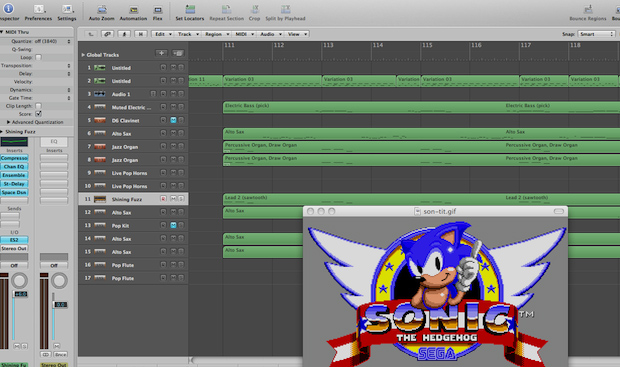How I Transcribed and Recorded "Sonic Meets Metal"

In today's day and age, technology has given musicians a way to produce something that used to take an entire band and engineer to do.
The digital world has made it possible for a single musician to sound like a three-piece classic rock band like Rush or even reaching the full titanic range of a film orchestra.
How? The answer is the power of the DAW (digital audio workstation). This week I'm going to go through the process of how I transcribed and recorded "Sonic Meets Metal."
A lot of games that were on Sega Genesis or Super Nintendo had great soundtracks. Nothing makes me feel more nostalgic than hearing the old-school eight-bit theme from my favorite games. When actually listening to a classic soundtrack from an old system, I realized the intricacy of what I was hearing. These game composers were geniuses!
I wasn't hearing just a melody line with a beat but line upon line upon line upon harmony upon counter melody, etc.
Problem 1: Is there any sheet music for these old game tracks so the musician can see all the parts? Not too likely; however, like I said earlier, the cyber world we have created is our savior. Online there are hundreds of old-school game sites that carry the free MIDI files we're looking for. Real quick, MIDI (musical instrument digital interface) is a electronic signal of what we are hearing, but what I use it for is the score.
Step 1: Import the MIDI file into the DAW. When the MIDI file is loaded, the next level to zone in would be the tempo. Because it's a MIDI file and not an audio file, yet the tempo can be manipulated. Once the song is at the speed it should be, the next step is to look at the piano roll. The piano roll is a note, velocity and intensity representation of the MIDI. The reason I use the piano roll is for the notes. You can see every part (the MIDI has to offer) as a single note line to determine the voicings.
Get The Pick Newsletter
All the latest guitar news, interviews, lessons, reviews, deals and more, direct to your inbox!
Step 2: Once the speed is correct and the voicings are understood, it's time to record. The first (and longest) part to recording is the drums. I work with Superior Drummer, which has the loops and patterns I like best, drum program-wise. Very simple once the pattern is found, drop and drag, drop and drag.
Then the guitars. I read an Andy Sneap forum that said that every backing track should be recorded four times over. The reason is widening. The wider the better. In essence, I record four rhythm guitar tracks panning two completely left and right, and two of them panning 3/4 of the way left and right. The second group of four tracks are basically there to accent the first four rhythm guitars, panning them the same way but slightly different.
The third group of four are the counter-melody guitars or the “high” rhythms, panned left and right about 50 to 40 percent. Almost there, bass guitar -– one track stereo center. And finally the two leads, panned 20 to 30 percent left and right.
Step 3: Mastering. After all that it's time to make it sound better. My lineup is very simple when it comes to mastering at the moment really because I am still learning more and more every day reading about it. I put an EQ on the entire track to balance the bass to treble frequencies, a multimeter to check the balance of bass to treble frequencies, a multipressor to compress the four frequencies for more balance, and finally an adaptive limiter to hold back clicks/pops and make the entire track LOUDER.
Afterwards, to make sure I've balanced everything correctly, I bring it to my car and listen to it a couple times. My car is the my mixing station ha ha. For some reason the stereo in my car gives me a perfect balance of what I'm looking for. If the mix satisfies me, as my dad says, bada-bing, bada boom.
Eric Calderone teaches and plays in Los Angeles, California; tries to get a YouTube video out every week; loves comics, movies and tattoos; is willing to trade lessons for ink -- and always has to give a shout out to the "tubers." \m/










